Technical Notes - e1
Impact of the NLM ILS on CATLINE® /AVLINE® /SERLINE® - e2
CANCERLIT® and PDQ® To Be Removed from the NLM Databases - Available from NCI's Web Site - e3
![]() Introducing Internet Grateful Med Version 2.6 [corrected 1998/11/24] - e4
Introducing Internet Grateful Med Version 2.6 [corrected 1998/11/24] - e4
NLM Online Training Program - 1999 - e5
Gold Standard Search - e6
Introducing Internet Grateful Med
Version 2.6
NLM is pleased to announce the release of Internet Grateful Med (IGM) version 2.6 on September 2, 1998. IGM version 2.6 has major changes that include:
- A new opening screen that allows you to choose a database on that page. See Figure 1.
- MEDLINE and PREMEDLINE searching through the PubMed retrieval system via one consolidated file covering 1966-current and eliminating the Backfiles
- Availability of related articles and links to publisher web sites for MEDLINE and PREMEDLINE
- New search screens for the following additional databases:
- BIOETHICSLINE
- ChemID
- POPLINE
- SPACELINE
- TOXLINE
- New hardware configuration with more powerful servers
- 1998 MeSH (from the 1998 UMLS Metathesaurus)
Figure 1 - Internet Grateful Med V2.6 - Initial Screen
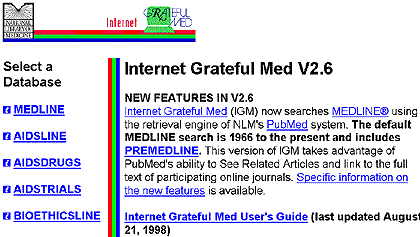
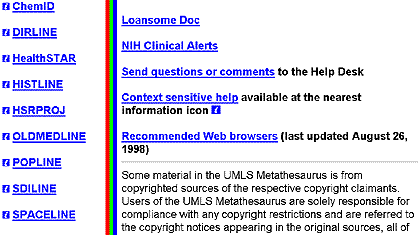

Future articles in the NLM Technical Bulletin will focus on searching BIOETHICSLINE, POPLINE, SPACELINE, ChemID, and TOXLINE via IGM.
What's New In Internet Grateful Med 2.6 For MEDLINE Searching
IGM is now searching MEDLINE and PREMEDLINE using the data from PubMed.
However, IGM and PubMed will not always get identical retrieval even when the same search
terms are entered in their search screens. This is because the IGM and PubMed interfaces each
have their own rules and syntax for searching. These differences will be explored in greater detail
in a future article. IGM is no longer searching MEDLINE using the ELHILL mainframe retrieval
engine. The default MEDLINE search is now all 9.2 million records of MEDLINE (including
PREMEDLINE) from 1966 to the present. IGM will continue to use the ELHILL mainframe
retrieval engine for all other databases offered, including the five new databases just added, until
the data in each is made directly accessible via the Web. IGM access to these ELHILL files will
incur no use charges.
Changes in the IGM Search Screen For MEDLINE Searching in PubMed
The Journals: selection box in the Apply Limits: section of the IGM Search Screen no longer
offers the choices of the Dental or Nursing subsets, because PubMed does not yet offer these.
See Figure 2. These choices will change when subsets are added in the future.
You can still create a personal journal list or a temporary journal list. When you return to the Search Screen after creating such a list, you will note that your journal list has been selected in the Limits section. You can return to the default of All Journals at any time, by clicking on the Journals: box and selecting All Journals. See Figure 2.
Figure 2 - IGM Journals: Display
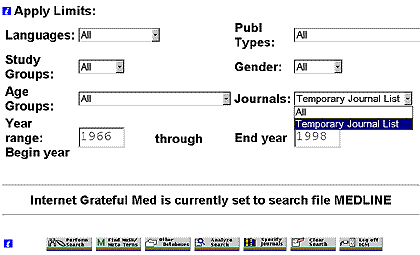
The Year Range: display box has changed the Begin year default from 1995 to 1966 (1966 is the default beginning year for PubMed) as shown in Figure 2. The ending default year is unchanged from the previous version of IGM and displays the current year. You can change the initial and ending years, within the 1966-1998 range, by clicking in the date boxes and typing in the desired years. Specific year ranges on pulldown menus do still exist in two of the databases (HealthSTAR and TOXLINE) accessible through IGM.
Changes in the IGM Results Screen For MEDLINE Searching in PubMed
There are six changes on the Results Screen:
- The default display of MEDLINE citations is 20, as in PubMed. Subsequent citations are also displayed in groups of 20. See Figure 3. Other databases still display citations in groups of eight.
Figure 3 - New Display Format for IGM V2.6 National Library of Medicine: IGM Results Screen
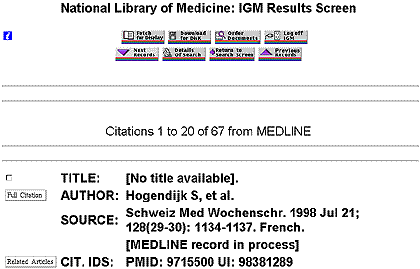
- The "Search Other Years" button is gone, as it is no longer needed. PubMed searches the entire MEDLINE file including PREMEDLINE at once. Use the Year range: feature as shown in
Figure 2 to limit the range of years for your search.
- The brief citation display and long citation display have been modified to accommodate the format of the data in PubMed. The brief display ( Figure 3) in IGM no longer includes an Affiliation statement, but it does show the PMID (PubMed Identifier number) next to the UI (Unique Identifier number assigned to MEDLINE records). Also note the term CIT. IDs: replaces NLM CIT ID:. The language indicator at the end of the Source information is also new and consistent with the format of the PubMed data. The indicator for the presence or absence of an abstract in a citation has been changed from (abstract present) next to the UI to "No abstract available." at the end of the Source data. Two publication types, Review and Retracted Publication, now appear in the brief citation display. See Figure 4.
Figure 4 - Brief Display with Review and No Abstract Available Statements

- The link to full citation including abstract has been changed from a hyperlink from the title, to a
button which says "Full Citation." This allows IGM to retain your checkbox selections when you
return to the Results screen after looking at a full citation. Previously, you would lose your
selections under those circumstances.
- A new "Related Articles" button is present on each citation (Figures 3 and 4) . You can go multiple levels down (related of related of related), and return either to the immediate Previous Related Results display (new button - Return to Prev. Results), or return to the original results display you viewed before you went to any Related Articles. See Figure 5.
Figure 5 - Return Buttons Available After Using Related Articles Feature National Library of Medicine: IGM Results Screen [corrected 1998/11/24]
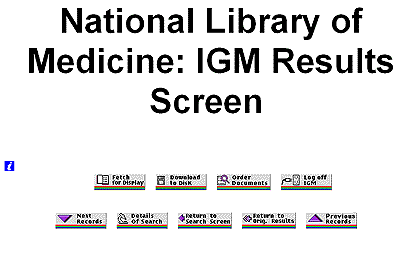
- A button offering to take you to the publisher's Web site is present on the Full Citation display when appropriate. See Figure 6. When invoked, a new browser window will appear with the publisher's site, leaving the IGM-to-PubMed window intact. Just close the new window when you're done at the publisher's site. Note that some publishers' sites permit free access, but others will require a subscription.
Figure 6 - New Button to Link to Publisher's Web Site
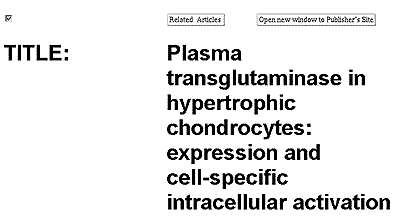
MeSH Headings Now Displayed Differently in All IGM Databases
Each MeSH heading/subheading combination is now displayed on a separate line in the full
citation display. In addition, each MeSH heading/subheading is categorized properly as a main
heading or an additional heading. See Figure 7.
Figure 7 - MeSH Headings as Shown in a Full Citation Display
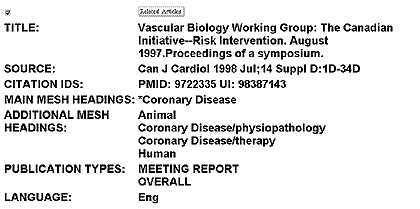
Navigating through IGM
Please remember to use the buttons from within IGM, such as: Return to Search Screen, Clear
Search, Previous Records, Next Records, etc. when you need to go back and forth between
screens. Do NOT use the forward and back buttons in your Web browser. IGM does not
recognize the browser's forward and back buttons as actions performed against the database and
using these buttons may cause a timeout resulting in a disconnect message.
The "Back" button is appropriate for returning from things like Help text, but use the IGM action buttons when you can. It makes a big difference in helping to avoid disconnects and timeouts.
Hints for the ELHILL Command Language Searcher
Please note the following four differences in the way IGM searches. If you type in a forward slash (/) in IGM, it means that you are overriding the IGM search syntax
and substituting the search syntax of the underlying database. For MEDLINE, it is PubMed search syntax; for all the
other files available in IGM it is ELHILL search syntax.
- If you start a line with a forward slash in an IGM MEDLINE search and you want to specify
the field, you must post-qualify and use square brackets not parentheses, e.g. /skin diseases [mh].
- If you want to turn off the automatic explosion feature in an IGM MEDLINE search, you
must post-qualify your term with [mh:noexp] after the slash, e.g., /skin diseases [mh:noexp]
- When you search a MeSH heading/subheading (MH/SH) combination in an IGM MEDLINE
search (with or without the forward slash), both the heading and the subheading
are exploded automatically, e.g., skin diseases/therapy, and the exploded subheadings are directly
attached to the MeSH headings. This capability, which is new in IGM v2.6, allows a single
MH/SH combination to retrieve a larger and more precise data set than was previously possible in ELHILL
where the subheadings do not explode when directly attached.
- If you want to type Boolean operators (AND, OR, NOT) into an IGM MEDLINE search box that has a forward slash, then you must capitalize the AND, OR, NOT, e.g. /skin diseases AND therapy. Remember that PubMed uses NOT (ELHILL uses AND NOT).
Please note that in every one of the four features highlighted, the explanations apply only to IGM MEDLINE search operations. If you put a forward slash on an IGM search screen for other files you default to ELHILL search syntax. Look for a future article comparing how the forward slash operates when you are searching MEDLINE in IGM (defaulting to the PubMed search syntax) vs. searching any other database in IGM (defaulting to the ELHILL search syntax).
Bugs Fixed
A number of reported bugs have been fixed in this version, including a difficult intermittent one
involving sometimes-scrambled abstracts, several having to do with the personal journal lists, and
several which could cause unwanted timeouts and disconnects.
The number of users and searches handled by the Internet Grateful Med system each month has increased steadily. We have added memory, processors and disk capacity to the IGM network of computers. A comprehensive hardware upgrade has expanded system capacity significantly. Please send your comments and questions about the new version of IGM to: access@nlm.nih.gov.
- --prepared by
- Anna Harbourt
- Lister Hill National Center for Biomedical Communications
- Toby Port
- MEDLARS Management Section
